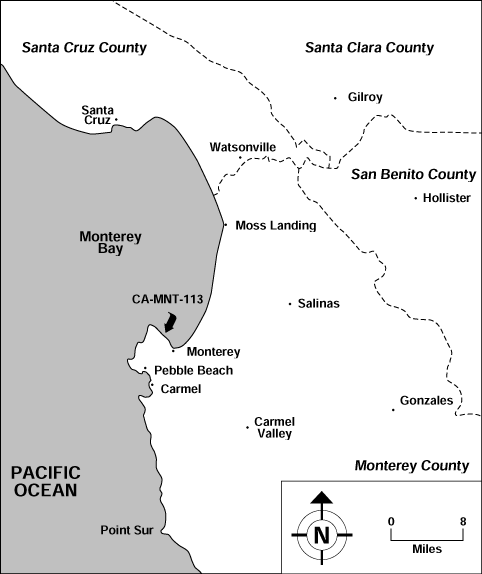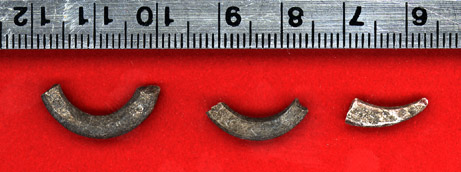 |
 |
 |
|
|
AMS RADIOCARBON DATES
ON THREE MUSSEL SHELL FISHHOOKS FROM CA-MNT-113C,
PACIFIC GROVE, MONTEREY COUNTY, CALIFORNIA
by
Gary S. Breschini and Trudy Haversat
July 28, 2001
 |
 |
 |
|
|
AMS RADIOCARBON DATES
ON THREE MUSSEL SHELL FISHHOOKS FROM CA-MNT-113C,
PACIFIC GROVE, MONTEREY COUNTY, CALIFORNIA
by
Gary S. Breschini and Trudy Haversat
July 28, 2001
A minor archaeological project, consisting of a single excavation unit along the coast of Pacific Grove, produced AMS radiocarbon dates on three mussel shell fishhook fragments.This represents a greater frequency of these rare artifacts than we have seen anywhere on the Monterey Peninsula. The radiocarbon dates we obtained on these specimens represent, as far as we know, the first radiocarbon dates on mussel shell fishhooks in Central California.
The area currently designated CA-MNT-113C was originally recorded as CA-MNT-115 by Arnold Pilling. Pilling's 1949 site record was based on a 1935 survey conducted by Edna Fisher. Two additional sites, CA-MNT-114 and CA-MNT-113 were recorded immediately east of CA-MNT-115. These three sites were subsequently combined. As such, we have used CA-MNT-113A to refer to the original CA-MNT-113, CA-MNT-113B to refer to the original CA-MNT-114, and CA-MNT-113C to refer to the original CA-MNT-115.

Figure 1. Location of CA-MNT-113.
The unit was excavated using our standard field procedures; that is, 10 cm arbitrary contour levels, with all recovered soils screened through 1/8 inch mesh portable shaker screens. No sorting was done in the field, except that any artifacts which were noted were immediately removed and separately bagged. When artifacts or features were encountered in the floor of a unit, they were carefully exposed and recorded. Also, large shells, even when judged not to be associated with features, were generally profiled, photographed, and collected as the excavation proceeded; several radiocarbon samples came from these specimens. Field notes for all levels of each unit were kept on standardized level record forms, and photographs were taken and drawings made as necessary.
All materials which did not pass through the 1/8 inch screens were bagged, labeled, and transported to the laboratory for wet screening (using 1/8 inch mesh), air drying on window mesh, and sorting prior to analysis.
Ella Rodriguez, a documented descendant of local Ohlone and Esselen peoples, served as the Native American consultant during the project.
The discovery of three fragments in an 80 cm unit represents an average density of 3.75 per cubic meter, the highest density of which we are aware for the Monterey region.
Curved mussel shell fishhooks are thought to associate with the Middle and Late Periods in the Monterey Bay area. They reportedly first occurred in Southern California about 2,500 years B.P. and continued to be used there in various forms until the Spanish mission period.

Figure 2. Three Mussel Shell Fishhook Fragments. Scale is in centimeters.
From left to right: Cat. Nos. 113-003, 113-004, 113-009.
Radiocarbon Dating
We are not aware of any mussel shell fishhooks which have previously been dated in central California, although abalone and bone fishhooks have been dated in southern California.
| Meas. age | Lab. No. | Material | Provenience | |||
| 2290 ± 50 | Beta-138060 | Shell-Mytilus | Unit 1, 20-30 cm | 0.3 | ||
| 2060 ± 50 | Beta-138061 | Shell-Mytilus | Unit 1, 20-30 cm | 0.7 | ||
| 2260 ± 50 | Beta-138062 | Shell-Mytilus | Unit 1, 40-50 cm | 0.1 |
Dietz, S.A. and T.L. Jackson, 1981. Report of Archaeological Excavations at Nineteen Archaeological Sites for the Stage 1 Pacific Grove-Monterey Consolidation Project Regional Sewerage System. Four volumes. Ms. on file, Northwest Regional Information Center of the California Archaeological Inventory, Sonoma State University, Rohnert Park.
| Copyrights 2022 californiaprehistory.com | Back to the Top |